Many legendary baseball players developed their skills in batting cages, highlighting the critical role these facilities play in the sport. Batting cages are not just a practice tool; they are essential for refining technique and enhancing performance. The importance of lighting in these cages cannot be underestimated, so much so that multiple recommended lighting standards exist to ensure players get the most out of their practice sessions.
Traditional bulbs often fall short of providing the necessary lux levels for adequate illumination. To ensure a batting cage is properly lit, it’s important to understand the specific requirements.
In the sections that follow, you’ll explore why achieving the right light level is crucial. We’ll also touch on the benefits of using LED lights, which will be discussed in greater detail later. Additionally, you’ll learn about the specific lux requirements needed for effective lighting. This includes key differences between lighting standards for indoor and outdoor batting cages, as well as common installation challenges and practical solutions to overcome them.
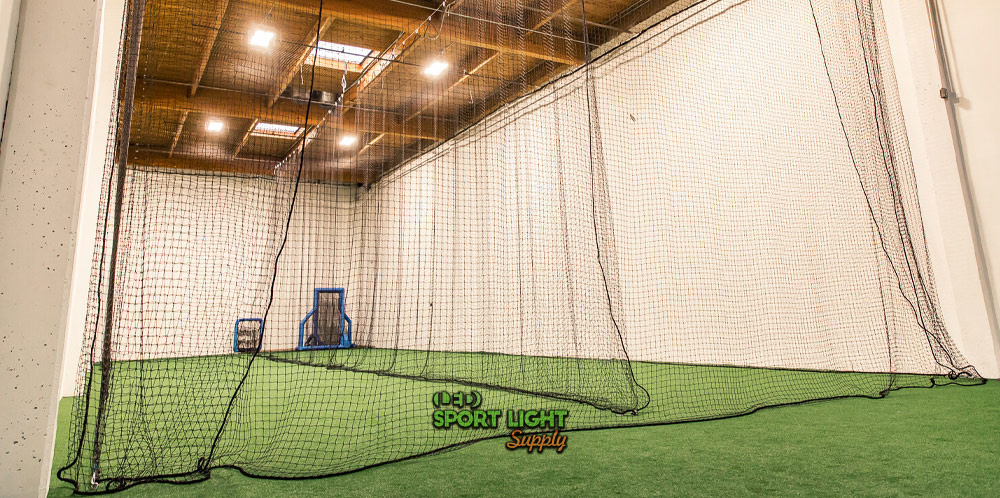
Table of Contents
ToggleImportance of Proper Batting Cage Lighting
In a batting cage, a hitter’s focus must remain unwavering, with eyes locked on the ball. Even a momentary lapse, like a single blink, can result in a missed opportunity. Successfully making contact with a high-speed baseball hinges not only on skill but also on the ability to see the ball clearly. Uniform lighting is crucial for ensuring that every training session is effective, and can make or break a player’s practice.
Glare should never be an issue in a batting cage, but if the cage is positioned near one of the bright lights used to illuminate a baseball field, excessive brightness can become a problem. Understanding these potential issues is essential for setting up effective batting cage lighting.
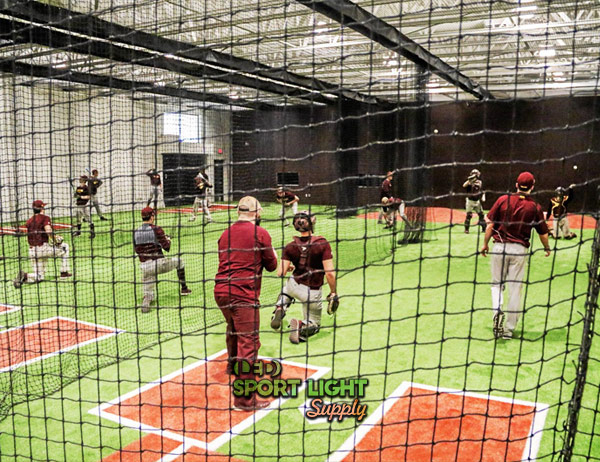
Baseball Player Experience
Achieving bright and uniform lighting is essential for enhancing a baseball player’s performance. Quality artificial lighting replicates the effects of natural sunlight, which not only improves visibility but also positively influences the player’s psychological state. A well-lit environment boosts performance, while poor lighting can create an unproductive and even uncomfortable atmosphere.
Psychologically, good lighting can help dispel fear and anxiety, allowing young batters to focus on improving their grip and stance. In essence, proper lighting helps hitters build confidence and perform at their best. For indoor baseball facilities, coaches can adjust the lighting to match the lux requirements of actual games, making training sessions more intense and realistic. Even subtle changes in lighting can affect a player’s physiological response, enhancing the overall training experience.
Safety of Baseball Players
It’s important to remember that a baseball player is never alone inside the batting cage; the pitching machine is also a critical part of the setup. Poor lighting can pose a serious risk, as it might hinder the batter’s ability to see the ball clearly, increasing the chance of injury. A well-designed lighting system should enhance visibility, allowing players to track fast-moving baseballs with ease.
Outdoors, appropriate lighting is essential for preventing accidents caused by loose dirt, waterlogged lawns, or uneven ground. A batter’s focus might be solely on hitting the ball, but without proper lighting, unseen hazards could lead to injury before practice even begins.
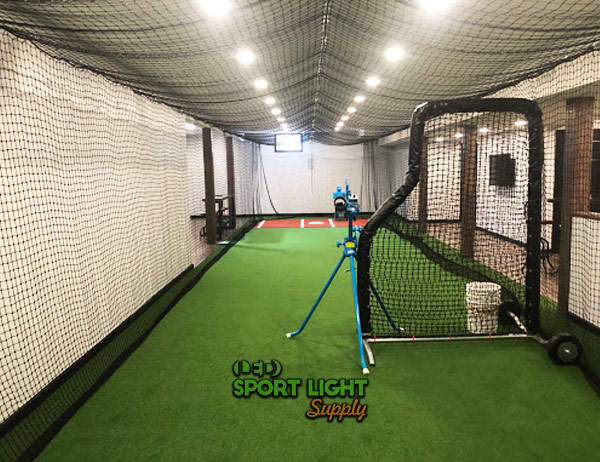
Security of Indoor Baseball Facilities
Proper lighting also plays a key role in the security of indoor baseball facilities. Many floodlight models are excellent for securing the perimeter of a sports facility or backyard, and options like motion sensor lights can automatically illuminate the area in response to unauthorized entry.
Energy-efficient LED lights can deter criminal activity by providing continuous illumination, even when you need to step away for a few hours. Additionally, remote control features can enhance the effectiveness of video surveillance systems. By creating a lighting profile that provides diffuse light before dusk, you ensure that the surveillance system records everything clearly. Later, when the profile switches off, night vision security cameras can operate without interference, maintaining the facility’s security around the clock.
Lighting Requirements for Batting Cages
The primary goal of lighting requirements in a batting cage is to replicate the experience of standing in the batter’s box. Proper lighting is essential not just for illuminating the batter’s mat but also for helping players focus and develop their skills. The way we perceive everything in a space—volumes, shapes, colors, surface textures—is influenced by light. For example, when you see a baseball in motion, you are actually seeing the light reflected from its surface.
Establishing rules for batting cage lighting sets the ideal conditions for each training session. Specific drills might be necessary to refine batting mechanics or correct bad habits, such as not running immediately after hitting the ball. Therefore, creating the right lighting environment is crucial for effective training.
Several factors influence the effectiveness of batting cage lighting:
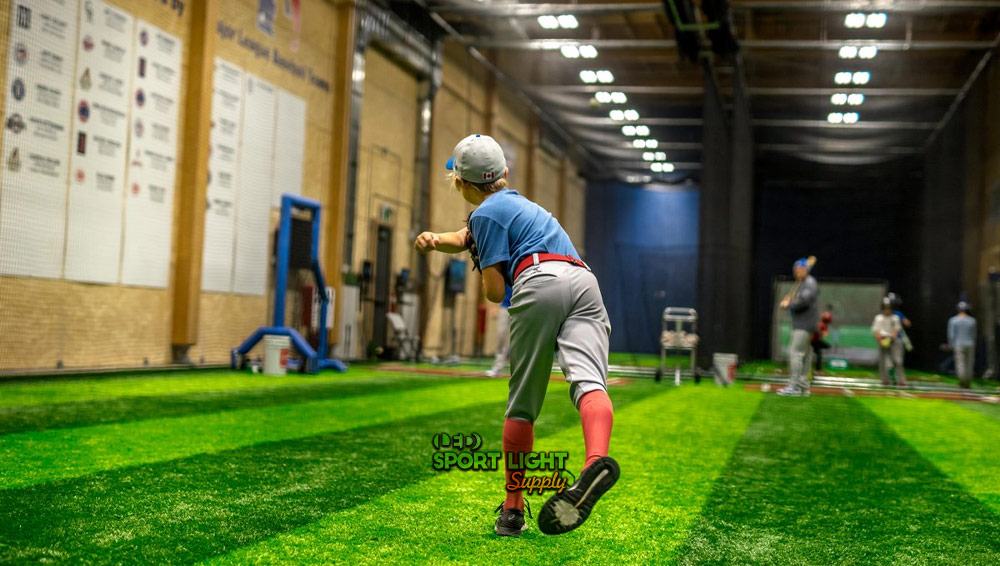
Lux (Brightness) Requirement
To illuminate a batting cage effectively, it is essential to determine the appropriate lux level. With the advent of LED lighting, terms like lumens, footcandles, and lux have become common in discussions about lighting. Lux is a key photometric unit that measures illuminance, or the amount of light per unit area. It is expressed as lumens per square meter (1 lux = 1 lm/sq.m). Recommended lux levels for batting cages vary depending on the setting:
| Setting | Recommended Lux Levels |
|---|---|
| Residential | 150 to 300 lux |
| Baseball clubs, high schools, colleges | 400 to 500 lux |
| Professional or televised venues | 700 to 1000 lux |
To find the necessary lumen output for your batting cage, divide the desired lux level by the cage’s area.
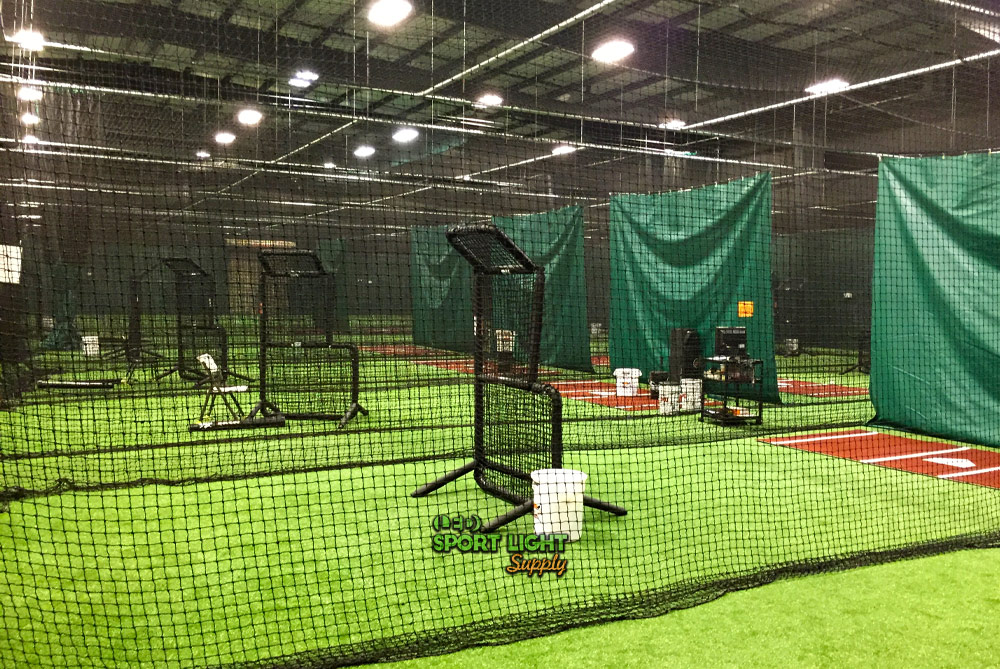
Lighting Uniformity
Beyond brightness, other important factors such as glare, color rendering, shadows, contrast, and uniformity of illumination play significant roles. Uniformity refers to the even distribution of light across a space. After installing light fixtures, it is important to check the uniformity of lighting. This can be calculated by dividing the distance between two light sources by their height (the perpendicular distance between the lights and the ground). For optimal results, light sources should be placed on the same horizontal axis, with uniformity values between 0.4 to 0.5 for recreational use and 0.6 to 0.7 for professional settings.
Beam Angle
When installing lighting for an outdoor batting cage, you may need to mount floodlights on walls or poles, requiring the selection of an appropriate beam angle. Similarly, in an indoor facility, choosing the right beam angle can help save on electricity costs. Each light fixture has its own beam angle—floodlights typically offer a wide angle, while spotlights produce a narrow beam of light. For indoor facilities:
| Ceiling Type | Recommended Lighting | Beam Angle |
|---|---|---|
| Low Ceilings | Floodlights | 90 to 120 degrees |
| High Ceilings | Spotlights | 25 to 45 degrees |
Glare
Proper arrangement and number of light fixtures should ensure uniform illumination while avoiding glare. Glare, a disturbing visual effect caused by uneven light distribution or high contrast, can hinder a player’s performance. High-quality lighting should minimize glare, and many lighting designers calculate the Unified Glare Rating (UGR) to address this issue. A UGR of less than 50 is recommended for batting cages. If you experience glare, consider adjusting the angle of the lights or dimming them slightly if possible.
Color Temperature
The human eye perceives different wavelengths of light with varying intensity, affecting our response to colors. Light sources emit various wavelengths, but we perceive them as a single color—this is known as color temperature. LED lights, available in both warm and cool white, are a popular choice for batting cage lighting. Warm white (2,500-5,000 K) has a slightly yellowish hue, while cool white (5,000-7,000 K) is a bright white light with more blue tones. Some players may prefer warm white because it mimics daylight, while others may favor cool white for better focus on the ball.
Shadow
In batting cage lighting, the aim is to create soft shadows rather than harsh contrasts. Adequate lighting spacing and the placement of LED lights from multiple angles can help achieve this, ensuring that shadows do not obstruct the player’s view. In official games, lux levels and light positions are arranged to minimize shadows on the field, and the same principle should apply in batting cages. Side lighting is especially useful for maintaining good visibility when uniform lighting cannot be achieved from all directions.
Flicker-Free Lighting
Flicker-free LED lights are essential for maintaining player comfort and performance. Even if flicker is invisible to the naked eye, it can cause discomfort and fatigue over time. Studies have shown that flickering lights can lead to migraines, eyestrain, and nausea. In some cases, prolonged exposure to flicker can affect visual acuity and overall health. Flicker can negate the benefits of extended training sessions, as players may become fatigued more quickly. This effect is often more pronounced in women and children, though some men and older individuals are also sensitive to flickering lights. Choosing flicker-free lighting helps ensure that training remains effective and players stay focused.
Difference Between Indoor and Outdoor Batting Cage Lighting Standards
When lighting a batting cage, the standards differ significantly between indoor and outdoor setups due to the unique challenges and requirements of each environment.
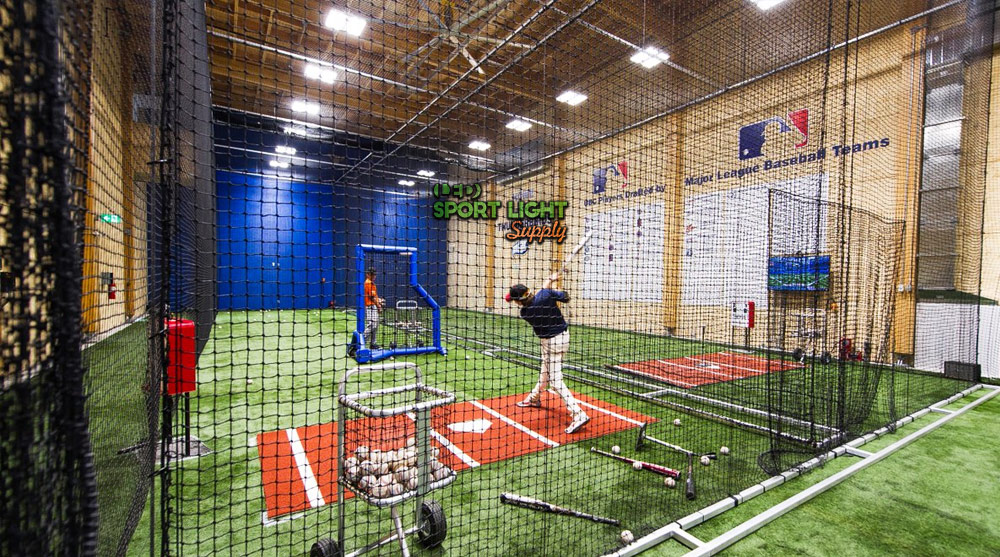
Indoor Batting Cage Lighting
For indoor batting cages, you have the option of using either indirect or direct lighting methods. Indirect lighting involves pointing the light fixtures upward, allowing the reflected light to illuminate the batting cage. This approach often results in higher lighting uniformity, which can create a more comfortable and visually pleasing environment for batters. However, it requires more powerful lights to compensate for the light lost during reflection, leading to higher costs.
Direct lighting, on the other hand, involves positioning the lights to shine downward directly onto the playing area. While this method may be less costly and more straightforward to implement, it might not provide the same level of uniformity as indirect lighting.
Indirect lighting is particularly suited for indoor environments where the ceiling can be utilized for light reflection. This method would be impractical for outdoor settings where upward-facing lights would be ineffective and could contribute to light pollution.
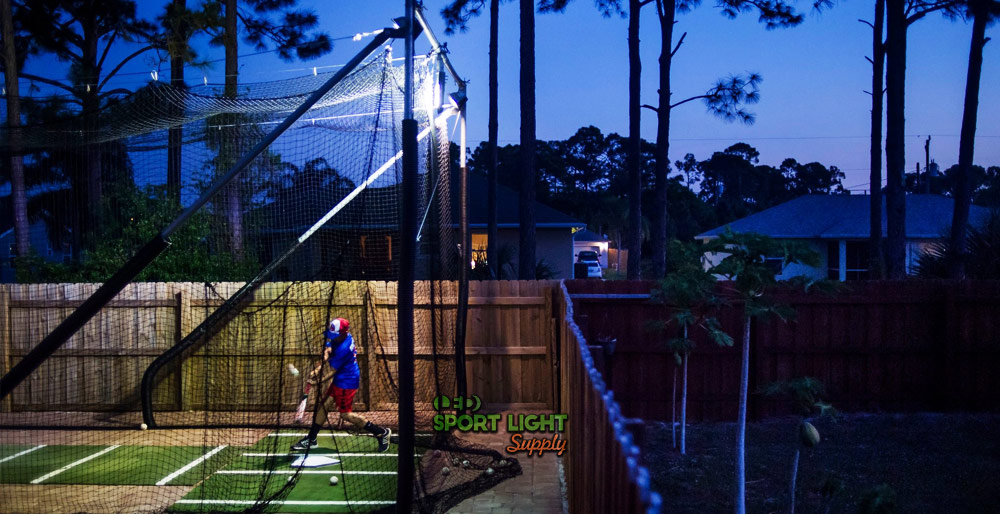
Outdoor Batting Cage Lighting
Outdoor batting cage lighting presents its own set of challenges, with light pollution being the primary concern. Light pollution occurs when artificial light spills into unintended areas, potentially disturbing wildlife, affecting neighboring properties, and contributing to environmental issues.
To minimize light pollution, careful consideration must be given to the placement and orientation of light fixtures. Properly positioned light poles are essential, with typical setups including 4, 6, or 8 pole arrangements depending on the size and layout of the batting cage. The angle at which the lights are projected, known as the tilt, is also crucial. A photometric study, such as one conducted using DIALux software, can help determine the optimal angle and position for the lights to ensure that the illumination is focused on the batting cage without spilling into surrounding areas.
Unlike indoor facilities, outdoor batting cages require a more targeted approach to lighting to ensure that the illumination is contained within the designated area. The goal is to provide sufficient lighting for players while preventing excess light from affecting the environment beyond the cage.
Common Problems with Batting Cage Lights
Proper lighting is crucial for an effective and safe batting cage experience. Here are some common issues that can arise with batting cage lights and how to address them:
Lights Are Too Bright
Excessive brightness in a batting cage can lead to problems such as glare and reduced safety conditions. Bright lights can inhibit melatonin production, affecting sleep quality and overall well-being. This can make players feel more nervous and less focused.
To address this issue, focus on the lumen output of the lights rather than their wattage. The lumen per watt ratio is a more accurate measure of lighting efficiency. Calculate the necessary lumen output by multiplying the desired lux level by the area to be covered (in square meters). Check the lumen per watt ratio of each light fixture or use a wattage equivalence chart popularized by LED lights to determine the appropriate number of lights needed.
Lights Are Too Dim
Dim lighting is unsuitable for a batting cage, where visibility is crucial for safety and performance. Insufficient lighting can make it difficult to see the baseball, leading to safety risks and potential accidents.
LED lights often come with dimming options, but over-dimming can lead to insufficient illumination and violate lighting standards. A dim bulb may indicate that it is time to replace the light, as light efficiency decreases over time. While LED lights are known for their longevity, they can still degrade or fail, requiring replacement to maintain optimal lighting conditions.
Selecting the Wrong Beam Angle
Choosing the incorrect beam angle can affect the effectiveness of the lighting in a batting cage. Broad beam angles are ideal for short-range illumination, as they distribute light evenly across the area. This helps prevent bright and dim spots that can cause eye strain, dizziness, and poor posture.
For long-range lighting, narrower beam angles are more appropriate. Spotlights with focused beams provide intense illumination over greater distances. Ensure that the beam angle aligns with the specific needs of your batting cage to create optimal lighting conditions.
Wrong Light Color Temperature
LED lights offer a wide range of color temperatures, which can impact visual comfort and performance. If the color temperature is too low (below 2,800 K), the light will appear too yellowish, while temperatures above 6,500 K result in a bluish hue.
For most batting cages, a color temperature around 5,000 K is ideal, as it mimics natural daylight and provides balanced illumination. This helps with color rendering and ensures that batters can see objects as they would in natural light. Avoid extreme color temperatures to prevent performance issues and ensure consistent lighting conditions during practice and games.
Conclusion
For a standard backyard batting cage measuring 23x4x3.5 meters (70x14x12 feet), the lighting should achieve between 150 and 300 lux to provide adequate visibility for practice. For baseball clubs, high schools, and college facilities, the lighting requirements increase to a range of 400 to 500 lux, which helps to simulate game-like conditions and improve player performance. In contrast, professional and televised baseball venues demand the highest levels of illumination, with lux levels ranging from 700 to 1,000. By addressing common lighting issues such as brightness, dimness, beam angle, and color temperature, and adhering to these recommended standards, you can ensure that the batting cage provides a safe, effective, and consistent training environment for players.
